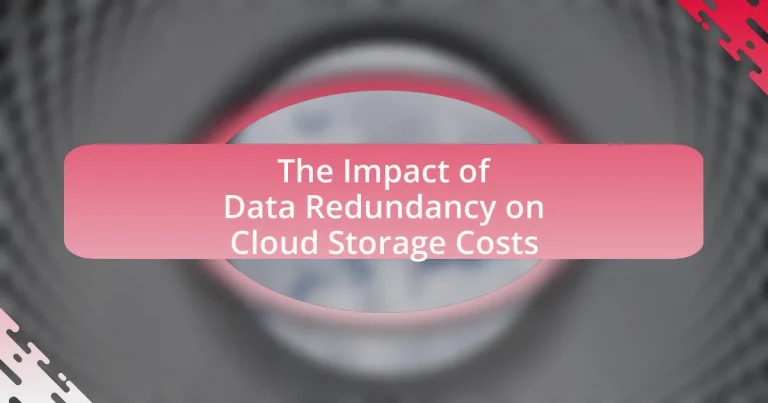Data redundancy in cloud storage significantly impacts costs by increasing the amount of storage required to maintain multiple copies of data. This article explores how different types of redundancy, such as full and partial redundancy, influence overall expenses and the financial implications for organizations. It discusses the benefits of redundancy for data integrity and disaster recovery, while also highlighting the hidden costs and challenges associated with excessive redundancy. Additionally, strategies for managing data redundancy effectively, including deduplication and data lifecycle management, are examined to optimize cloud storage costs.
What is the impact of data redundancy on cloud storage costs?
Data redundancy significantly increases cloud storage costs. When data is duplicated across multiple locations for backup or recovery purposes, it consumes additional storage space, leading to higher fees charged by cloud service providers. For instance, if a company stores 1 TB of data and duplicates it for redundancy, the effective storage requirement becomes 2 TB, resulting in doubled storage costs. This impact is particularly pronounced in environments where large volumes of data are stored, as the cumulative effect of redundancy can lead to substantial financial implications for organizations relying on cloud solutions.
How does data redundancy influence overall cloud storage expenses?
Data redundancy increases overall cloud storage expenses by requiring additional storage capacity to maintain multiple copies of the same data. For instance, if a cloud service provider implements a redundancy strategy that stores three copies of each file for reliability, the cost of storage effectively triples. This is particularly significant given that cloud storage pricing is typically based on the amount of data stored; thus, higher redundancy directly correlates with increased costs. According to a report by Gartner, organizations can incur up to 30% higher expenses due to inefficient data redundancy practices, emphasizing the financial impact of maintaining excessive copies of data in cloud environments.
What are the different types of data redundancy in cloud storage?
Data redundancy in cloud storage primarily includes three types: full redundancy, partial redundancy, and erasure coding. Full redundancy involves storing complete copies of data across multiple locations, ensuring high availability and reliability. Partial redundancy entails saving only critical data in multiple locations, which optimizes storage costs while still providing some level of data protection. Erasure coding breaks data into fragments, which are then distributed across different storage nodes, allowing for data recovery even if some fragments are lost. These methods are essential for maintaining data integrity and availability in cloud environments, directly impacting storage costs by influencing the amount of data stored and the complexity of data management.
How does each type of data redundancy affect storage costs?
Data redundancy affects storage costs by increasing the amount of storage required, which directly raises expenses. For instance, full data redundancy, where complete copies of data are stored, can lead to significantly higher costs due to the need for additional storage space. In contrast, partial redundancy, such as using techniques like deduplication or RAID configurations, can mitigate costs by optimizing storage efficiency while still providing data protection. According to a study by IDC, organizations can save up to 30% on storage costs by implementing deduplication strategies, demonstrating that the type of redundancy chosen can have a substantial impact on overall expenses.
Why is data redundancy implemented in cloud storage systems?
Data redundancy is implemented in cloud storage systems to enhance data availability and reliability. By storing multiple copies of data across different locations, cloud providers ensure that information remains accessible even in the event of hardware failures, data corruption, or natural disasters. This strategy is supported by industry practices, such as the use of distributed file systems and replication techniques, which have been shown to significantly reduce the risk of data loss and downtime, thereby improving overall service continuity.
What are the benefits of data redundancy for data integrity and availability?
Data redundancy enhances data integrity and availability by ensuring that multiple copies of data exist, which protects against data loss and corruption. When one copy of data becomes compromised, other copies can be used to restore the original information, thereby maintaining integrity. Additionally, redundancy allows for continuous access to data, as alternative copies can be accessed if the primary source fails, ensuring high availability. For instance, cloud storage providers often implement redundancy strategies, such as storing data across multiple geographic locations, which significantly reduces the risk of downtime and data loss. This approach is supported by industry practices, where companies like Amazon Web Services and Google Cloud utilize redundancy to guarantee data durability and accessibility, often achieving 99.999999999% durability rates.
How does data redundancy contribute to disaster recovery strategies?
Data redundancy significantly enhances disaster recovery strategies by ensuring that multiple copies of critical data are available in different locations. This availability allows organizations to quickly restore operations after a data loss event, such as a natural disaster or cyberattack. For instance, according to a study by the Disaster Recovery Journal, organizations with robust data redundancy measures can reduce downtime by up to 50%, demonstrating the effectiveness of having redundant data systems in place. This capability not only minimizes data loss but also accelerates recovery processes, thereby safeguarding business continuity.
What are the financial implications of data redundancy in cloud storage?
Data redundancy in cloud storage significantly increases costs due to the need for additional storage space and associated management expenses. When data is duplicated, organizations must pay for the extra storage capacity required to maintain multiple copies, which can lead to higher monthly fees from cloud service providers. For instance, if a company stores 1 TB of data and duplicates it for redundancy, it effectively incurs costs for 2 TB of storage, resulting in a direct financial impact. Additionally, managing redundant data can lead to increased operational costs, including data transfer fees and the need for more robust data management solutions. According to a study by Gartner, organizations can save up to 30% on cloud storage costs by optimizing data redundancy practices, highlighting the financial implications of inefficient redundancy strategies.
How do cloud service providers calculate costs related to data redundancy?
Cloud service providers calculate costs related to data redundancy by assessing the additional storage space required to maintain multiple copies of data. This involves evaluating the total amount of data stored, the redundancy level (such as replication or erasure coding), and the associated storage pricing tiers. For instance, if a provider uses a replication strategy that stores three copies of data, the cost will be three times the base storage cost for that data. Additionally, factors such as data transfer fees, retrieval costs, and the specific pricing model of the provider (e.g., pay-as-you-go or reserved capacity) also influence the overall cost calculation.
What factors influence the pricing models of cloud storage services?
The pricing models of cloud storage services are influenced by factors such as storage capacity, data redundancy, access frequency, and service level agreements (SLAs). Storage capacity directly affects pricing, as larger capacities typically incur higher costs. Data redundancy, which ensures data availability and durability, can increase costs due to the need for additional storage resources. Access frequency impacts pricing models as frequently accessed data may be priced differently compared to infrequently accessed data, often leading to tiered pricing structures. SLAs define the level of service and reliability expected, which can also influence costs, as higher guarantees often come with increased pricing. These factors collectively shape the pricing strategies adopted by cloud storage providers.
How does data redundancy impact the pricing tiers of cloud storage plans?
Data redundancy significantly influences the pricing tiers of cloud storage plans by increasing costs associated with data storage and management. Cloud providers implement redundancy to ensure data durability and availability, which typically involves storing multiple copies of data across different locations or systems. This practice requires additional storage resources and infrastructure, leading to higher operational expenses. For instance, services that offer high redundancy, such as multi-region replication, often charge more than those with basic redundancy options. According to a report by Gartner, organizations can expect to pay 20-30% more for cloud storage plans that include enhanced redundancy features compared to standard offerings.
What are the potential hidden costs associated with data redundancy?
The potential hidden costs associated with data redundancy include increased storage expenses, higher data management overhead, and potential performance degradation. Increased storage expenses arise because redundant data requires additional space, leading to higher costs for cloud storage services, which often charge based on the amount of data stored. Higher data management overhead occurs as organizations need to maintain, back up, and synchronize multiple copies of data, consuming both time and resources. Performance degradation can result from inefficient data retrieval processes, as systems may struggle to manage and access multiple redundant datasets, ultimately affecting application performance and user experience.
How can excessive data redundancy lead to increased operational costs?
Excessive data redundancy can lead to increased operational costs by consuming additional storage resources and increasing data management complexity. When multiple copies of the same data are stored, organizations incur higher expenses for storage solutions, as cloud providers typically charge based on the amount of data stored. For instance, a study by IDC found that organizations can waste up to 30% of their storage capacity due to redundant data, which translates to significant financial losses. Additionally, managing redundant data requires more time and resources for data backup, recovery, and maintenance, further escalating operational costs.
What are the risks of underestimating data redundancy costs?
Underestimating data redundancy costs can lead to significant financial and operational risks for organizations. These risks include unexpected budget overruns, as organizations may not allocate sufficient funds to cover the actual costs associated with storing duplicate data. Additionally, underestimating these costs can result in inefficient resource allocation, where funds are diverted from other critical areas, impacting overall business performance. According to a study by Gartner, organizations can waste up to 30% of their cloud storage budgets due to unoptimized data redundancy practices. This highlights the importance of accurately assessing data redundancy costs to avoid financial strain and ensure effective resource management.
How can organizations manage data redundancy to optimize cloud storage costs?
Organizations can manage data redundancy to optimize cloud storage costs by implementing data deduplication techniques. Data deduplication identifies and eliminates duplicate copies of data, significantly reducing the amount of storage space required. For instance, studies show that deduplication can reduce storage needs by up to 90%, leading to substantial cost savings in cloud storage fees. Additionally, organizations can utilize tiered storage solutions, where frequently accessed data is stored on high-performance storage, while redundant or infrequently accessed data is moved to lower-cost storage options. This strategic management of data redundancy not only minimizes costs but also enhances data retrieval efficiency.
What strategies can be employed to minimize unnecessary data redundancy?
To minimize unnecessary data redundancy, organizations can implement normalization techniques in database design. Normalization involves organizing data to reduce duplication by ensuring that each piece of information is stored only once, which can significantly lower storage costs and improve data integrity. For instance, according to a study by the University of California, Berkeley, effective normalization can reduce data storage requirements by up to 50%, demonstrating its impact on minimizing redundancy. Additionally, employing data deduplication technologies can further eliminate duplicate copies of data across storage systems, enhancing efficiency and reducing costs associated with cloud storage.
How can data deduplication techniques reduce storage costs?
Data deduplication techniques can significantly reduce storage costs by eliminating redundant copies of data, thereby optimizing the use of storage space. By identifying and removing duplicate data, organizations can decrease the amount of storage required, which directly lowers expenses associated with purchasing additional storage hardware or cloud storage services. For instance, a study by IDC found that data deduplication can reduce storage requirements by up to 90%, leading to substantial cost savings for businesses. This efficiency not only minimizes physical storage needs but also enhances data management and retrieval processes, further contributing to reduced operational costs.
What role does data lifecycle management play in controlling redundancy?
Data lifecycle management plays a crucial role in controlling redundancy by systematically managing data from creation to deletion, thereby minimizing unnecessary duplication. By implementing policies that dictate when data should be archived, retained, or deleted, organizations can effectively reduce the volume of redundant data stored in cloud environments. This reduction in redundancy directly impacts cloud storage costs, as less data stored translates to lower expenses. For instance, a study by IDC found that organizations can save up to 30% on storage costs by effectively managing data lifecycle processes, highlighting the financial benefits of controlling redundancy through data lifecycle management.
What best practices should organizations follow regarding data redundancy?
Organizations should implement a tiered data redundancy strategy to optimize storage costs and ensure data availability. This involves categorizing data based on its importance and access frequency, allowing organizations to apply different redundancy levels accordingly. For instance, critical data may require higher redundancy, such as replication across multiple locations, while less critical data can be stored with lower redundancy, reducing overall storage costs.
Additionally, organizations should regularly assess and update their redundancy policies to align with evolving business needs and technological advancements. According to a study by IDC, organizations can save up to 30% on storage costs by optimizing their data redundancy practices. This demonstrates that effective management of data redundancy not only enhances data protection but also significantly impacts cloud storage expenses.
How can regular audits of data storage help in managing redundancy?
Regular audits of data storage can significantly help in managing redundancy by identifying and eliminating duplicate data. These audits systematically review stored data, allowing organizations to pinpoint unnecessary copies that consume storage resources and inflate costs. For instance, a study by IBM found that up to 30% of data in enterprise storage can be redundant, leading to increased cloud storage expenses. By conducting regular audits, organizations can streamline their data management processes, reduce storage costs, and enhance overall efficiency.
What tools are available for monitoring and optimizing data redundancy?
Tools available for monitoring and optimizing data redundancy include data deduplication software, storage management solutions, and cloud monitoring platforms. Data deduplication software, such as Veeam or Commvault, identifies and eliminates duplicate copies of data, thereby reducing storage costs and improving efficiency. Storage management solutions like NetApp ONTAP provide insights into data usage and redundancy levels, allowing organizations to optimize their storage architecture. Additionally, cloud monitoring platforms such as AWS CloudWatch and Azure Monitor enable users to track data redundancy metrics in real-time, facilitating proactive management of storage resources. These tools collectively help organizations minimize unnecessary data duplication, ultimately lowering cloud storage costs.
What are the common challenges organizations face with data redundancy?
Organizations commonly face challenges with data redundancy, including increased storage costs, data inconsistency, and inefficient data management. Increased storage costs arise because redundant data consumes additional space, leading to higher expenses in cloud storage solutions. Data inconsistency occurs when multiple copies of the same data exist, resulting in discrepancies that can undermine data integrity and reliability. Inefficient data management is another challenge, as organizations struggle to maintain and synchronize multiple data copies, complicating data retrieval and analysis processes. These challenges can significantly impact operational efficiency and decision-making within organizations.
How can organizations overcome the challenges of managing data redundancy?
Organizations can overcome the challenges of managing data redundancy by implementing data deduplication techniques and centralized data management systems. Data deduplication reduces the amount of storage needed by eliminating duplicate copies of data, which can significantly lower cloud storage costs. For instance, a study by the International Data Corporation (IDC) found that organizations using deduplication can achieve storage savings of up to 90%. Additionally, centralized data management systems streamline data access and ensure that all users are working with the most current version of data, further minimizing redundancy. By adopting these strategies, organizations can effectively manage data redundancy and optimize their cloud storage expenses.
What lessons can be learned from organizations that have successfully managed data redundancy?
Organizations that have successfully managed data redundancy demonstrate the importance of implementing effective data governance and optimization strategies. These organizations often utilize data deduplication techniques, which significantly reduce storage costs by eliminating duplicate copies of data. For instance, a study by IBM found that data deduplication can lead to storage savings of up to 90%, showcasing the financial benefits of managing redundancy effectively. Additionally, successful organizations prioritize regular audits and monitoring of data storage practices, ensuring that only necessary data is retained, which further minimizes costs associated with cloud storage.


